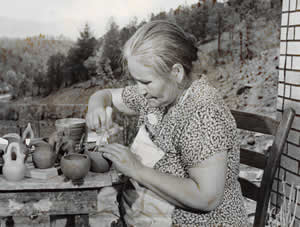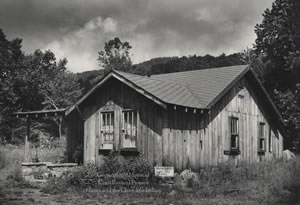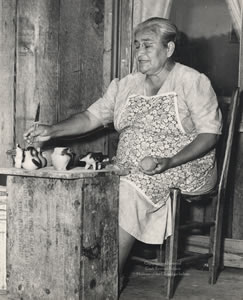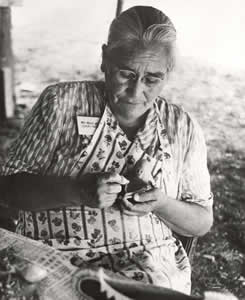People: Maude Welch
Maude French Welch (1894–1953) was was born near Cooper's Creek in the Birdtown section of the Qualla Boundary. In the 1920s she lived in South Carolina, where she met some of the most accomplished of Catawba potters. Returning to the Qualla Boundary, Welch began producing pottery in earnest and was quickly rewarded. Her work, sought-after and prizewinning, allowed her to contribute to the household income. While largely self-taught, Welch continued to add to her reportoire of traditional pottery forms and sometimes added hand-shaped embellishments. Welch used a variety of tools to shape her pottery and used the same polishing stone for more than twenty-five years. She briefly experimented with pottery kilns, but abandoned the practice because customers preferred her signature mottled tan and smoky-black pottery, achieved by more traditional methods. A 1935 report on pottery called her “the most talented potter on the Reservation,” and some contend that Welch led the revival of potters’ art among the Cherokee.
Maude French Welch (1894–1953) was born at the end of the nineteenth century near Cooper’s Creek in the Birdtown section of the Qualla Boundary. Welch was not from a family of potters, but she was related to the Owl family (with its intertwined Cherokee-Catawba pottery bloodlines), and her mother made baskets. Her daughter, Edith Welch Bradley, also was a potter.
Welch left Cherokee in 1925 to seek factory work, traveling with her children to Rock Hill, S.C., where she lived among and observed four of the Catawba tribe’s best potters: Rosie Harris Wheelock; her daughter, Doris Blue; Martha Jane Harris; and her granddaughter, Georgia Harris. The Welch family lived for a time with the Blues, with Doris Wheelock Blue recalling: “While they were here we were making pottery, and they watched us. They were real interested.” They moved in next with Georgia Harris. “They watched her make pottery with her grandmother, and they learned how to make pottery.” Blue concluded, “When they went back to Cherokee, they became experts.” Catawba scholar Thomas Blumer noted that the “Catawbas are adamant in their insistence that Maude Welch never worked in clay while visiting in their homes. She merely observed.” Still, such observation is consistent with traditional and familial ways of teaching and learning, and no doubt, Welch was able to absorb what she learned during her stay in South Carolina.
After Welch returned to the Qualla Boundary, she began producing pottery in earnest. Her daughter, Edith Welch Bradley, recalled, “After we moved back to Cherokee, Mama said, ‘Well, I believe I’ll try to make some pottery.’ She made a few canoes and bowls. She sold them and got some more clay.” It appears from her comments that Welch’s initial attempts at pottery making met with immediate success, a success that continued for years to come. Her daughter continued, “Every year Mama won first prize for her pottery.” Maude Welch remarked that she quickly learned that pottery sales could help with groceries; she could trade pots for “a sack of flour, some lard, and a box of salt.” 1
In North Carolina, Welch obtained clay for her first pieces of pottery from a neighbor. For a time, she traveled to South Carolina, a trip made as much for visiting friends as for digging clay. Afterward, she used the community clay hole at the Macedonia Church in Soco. When those deposits were exhausted, she purchased clay from Brown Pottery in Arden. Welch continued to add to her reportoire of traditional pottery forms by looking at photographs and museum pieces, making peace pipes, medicine bowls and wedding pitchers. Sometimes she added decorative lugs or Indian heads to her pots. These she formed entirely by hand, pressing them onto her pot while it was still wet. At one point, she did try using molds to make the heads, but the ones she formed by hand were so much better that she abandoned the molds. Welch used a variety of tools to shape her pottery and sometimes used a moist rag to smooth its surface. Anthropologist Vladimir J. Fewkes observed, “Her tools depend more on modern kitchen pieces than on native means.” Welch used small knives to shape her pottery and, like so many potters, used the same polishing stone for over twenty-five years.
Welch was aware of potter’s wheels and pottery kilns. In the mid 1930s, she taught for a time at the Cherokee Boarding School. Apparently, in its move to reintroduce Cherokee crafts into the school system, the federal Cherokee Indian Agency decided to modernize the process by introducing the use of kerosene-fired kilns. And like potter Rebecca Youngbird, Maude Welch was exposed to other potters through her attendance at outside fairs and festivals, including the 1940 Cherokee Indian Fair and at the Craftsman’s Fair of the Southern Highlands, held in Gatlinburg in 1949. 2
I learned how other pottery makers used kilns for the burning of their pieces. I decided I would try to make mine that way, but the people didn’t want it. They said mine were different—the only pieces of the kind anywhere—so, I decided to hang on to the old way, not to modernize.
Welch dried her pots in the sun before putting them into the oven of her kitchen stove. Once throroughly heated, she placed them into the firebox to complete the firing. The open flame added a finishing touch of color, producing work with a varied organic surface, ranging from light orange to dark brown in a natural color palette. Her “mottled tan and smoky-black pottery is recognized on sight,” one writer noted. 3
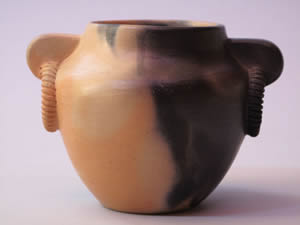
Flame-smoked vase by Maude Welch |
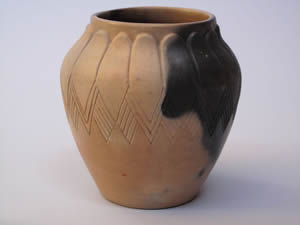
Flame-smoked vase by Maude Welch |
Welch was totally immersed in making pottery, noting that she felt “lost when she was not carving or polishing a piece.” Her work did not go unnoticed. A 1935 report on pottery called her “the most talented potter on the Reservation.” The writer concluded, “Maude Welch makes a unique type of pottery with many personal elements which was neither like old Cherokee pots nor Catawba.” Some have gone so far as to say that “the influence of Maude Welch, it seems, might have caused a complete revival of the potters’ art among the Cherokees.” 4
M. Anna Fariello
Biography excerpted from Cherokee Pottery: From the Hands of our Elders
Published by The History Press, 2011
1. Edith Welch Brady interview by Thomas J. Blumer (1979), Blumer Collection, University of South Carolina-Lancaster; Thomas Blumer, “Catawba Influences on the Modern Cherokee Tradition,” Appalachian Journal 14, no. 2 (Winter 1987), 162.
2. Edith Welch Brady interview; Vladimir J. Fewkes, “Catawba Pottery-Making with Notes on Pamunkey Pottery-Making, and Coiling,” Proceedings of the American Philosophical Society 88 (July 7 1944), 100; Rodney L. Leftwich, Arts and Crafts of the Cherokee (Cherokee: Cherokee Publications, 1970), 81.
3. Smoky Mountain Indian Trail, Cherokee, N.C., (April 25, 1934); Leftwich, Arts and Crafts,86; Dinah Smoker Gloyne, “Cherokee Craftsmen,” Mountain Life and Work 26 (1951), 16; Raymond S. Stites, “Kilns for the Cherokee,” 1935, 4, National Archives and Records Administration, Southeastern Division.
4. Fewkes, “Catawba Pottery-Making,”81; Leftwich, Arts and Crafts, 81; Raymond S. Stites, “Kilns for the Cherokee”; Blumer, “Catawba Influences,” 163.

